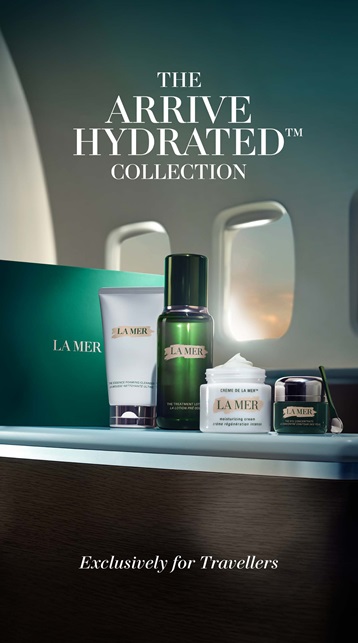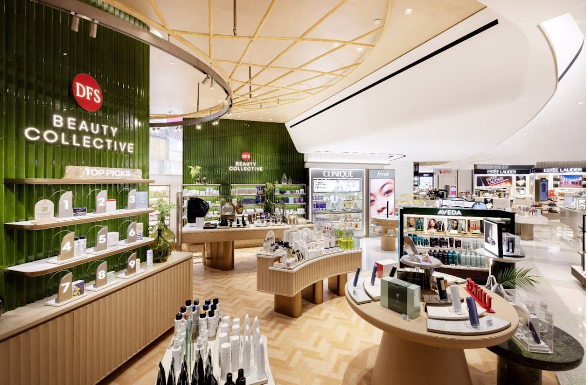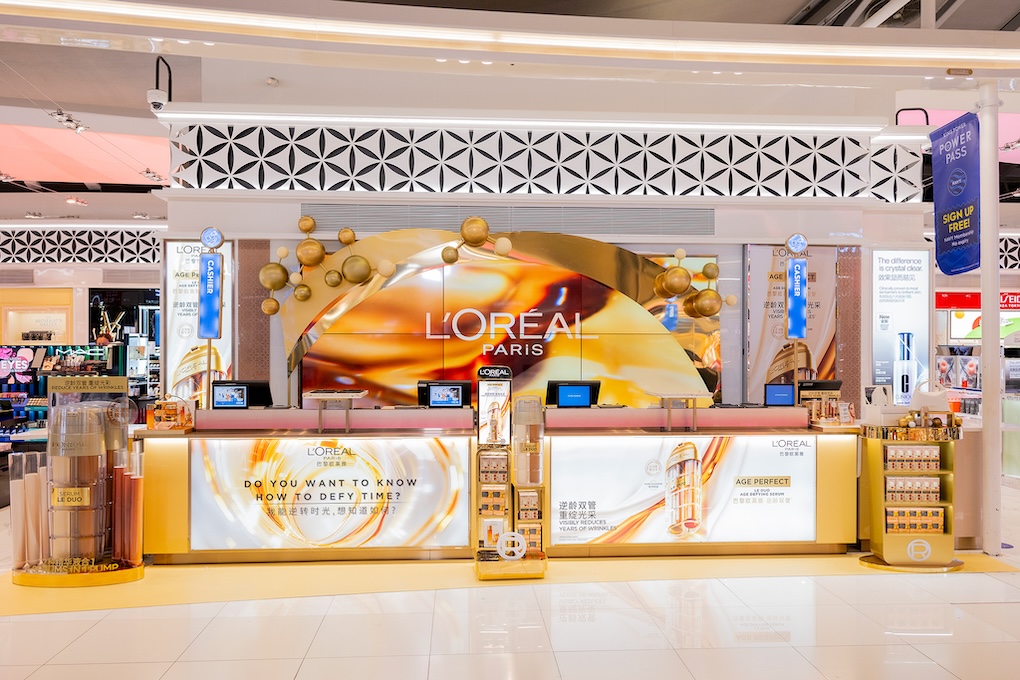US beauty group The Estée Lauder Companies (ELC) yesterday underlined the challenges faced by its key travel retail business in two pivotal markets – Hainan and South Korea.
As reported, declining sales in these locations were the key driver in an -8% year-on-year fall in groupwide organic set sales to US$3.75 billion for the third quarter ended 31 March announced yesterday.

Dual headwinds
Speaking on an earnings call, President and Chief Executive Officer Fabrizio Freda said: “Nearly all developed and emerging markets grew organically, and outperformed our expectations to offset an even lower-than-expected recovery in our Asia travel retail business.

“As we discussed in February, Asia travel retail faced two headwinds in the third quarter. The first, elevated inventory in Hainan, given retailers’ expectation for a more accelerated recovery, proved very challenging.” Freda said this was driven by conversion of travellers to consumers in prestige beauty lagging historical trends, as travellers initially gravitated to other categories. “This led to even lower replenishment orders than we anticipated,” he noted.
“The second headwind – the transition in Korea to post-pandemic regulations as travelling consumers gradually returned – pressured sales meaningfully. In China and Korea, the resumption of international flights was subdued. Limited visas were granted, and group tours were slow to restart.

“These factors resulted in lower-than-expected traffic in airports throughout the region, which combined with a lower-than-expected conversion further moderated replenishment orders.” {Main story continues below the Goldman Sachs sidebar}
Goldman Sachs maintains ‘Buy’ ratingIn a note, Goldman Sachs acknowledged the disappointing nature of The Estée Lauder Companies’ results but reiterated its ‘Buy’ rating. It said: “We reset our expectations lower, but still see a meaningful top and bottom line inflection later this year. We view our earnings recovery thesis as deferred rather than permanently derailed and reiterate our Buy rating in this context.” On the question of the inventory issues raised in the results, the Goldman Sachs said:“Based on the recent guidance revision, as well as management’s guidance for inventory destocking to remain a headwind through 1Q23, we estimate that the company is one quarter into working through a US$1.5 billion inventory problem. “We believe this problem should be behind it by the end of 1Q23 assuming a US$2.5 bn run-rate demand trajectory in Hainan; a figure we peg below our estimated $US3.1 billion FY22 Hainan sales estimate when we believe the company benefited from disproportionate Daigou sales (given international travel restrictions) and a pipeline fill into the Haikou shopping center [cdf Haikou International Duty Free Shopping Complex, which opened on 28 October -Ed].” Looking forward, it added: “As we taper our expectations on travel retail recovery and contemplate that the historical sales levels were likely inflated by excessive shipments (thereby leading to the current inventory problems) we modify our forward estimates. “FY23/FY24/FY25 EPS estimates are to fall by -33%/-32%/-15% respectively. As we lower our estimates we also lower our 12 month price target to $266, from $302. Our target remains based on an equal weighted 32X P/E and 20X EV/EBITDA on Q5-Q8 estimates.” The report concluded: “Downside risks include continued weakness/share losses in developed markets (US and Europe), greater-than-expected headwinds in China/Hainan, and slower-than-expected travel retail recovery and/or further contraction in global mobility.” |
More positively, Freda highlighted bright spots for travel retail in Hong Kong, Macau, Europe, and the Americas. “All told, global travel retail organic sales declined -45%,” he said. “This was partially offset by excellent organic sales growth of +10% in the rest of our global business. Our retail sales growth was even stronger than organic sales growth in many markets around the world, including China and the US.
“Encouragingly, retail sales performance is significantly ahead of organic sales result in global travel retail, which gives us confidence that the challenges in travel retail are abating with time.”
Executive Vice President and Chief Financial Officer Tracey Travis added: “From a geographic standpoint, organic net sales in our Asia Pacific region rose +7% with nearly all markets contributing, led by Hong Kong which doubled in size partially due to the return of Chinese travellers.
“Organic net sales in our Europe, the Middle East, and Africa regions fell -24%, driven entirely by the travel retail business. Our global travel retail sales continue to be pressured by our Asia travel retail business… [but] outside of Asia, we experienced double-digit sales growth in travel retail, as international travel increased throughout Europe and the Americas.”

Travis said travel retail’s overall performance more than offset the organic net sales growth from the rest of the EMEA region, notable for strong performance in all product categories and from nearly all distribution channels. Organic net sales rose across both developed and emerging markets, led by the UK, Germany, France, Italy, and Turkey, as the progression to recovery continued, and tourism resumed.
Makeup and skincare hit by Asian travel retail downturn
Makeup growth in the Americas, Asia Pacific, and the markets in EMEA, excluding travel retail, was offset by the pressures in Asia travel retail. Organic net sales in skincare fell -17%, again due to the pressures affecting Asia travel retail. Declines from La Mer and Estée Lauder were partially offset by standout performances from The Ordinary and M·A·C.
Travis said the group’s gross margin declined 750 basis points compared to last year, largely due to the slower-than-expected recovery in Asia travel retail.
A perfect storm
Delivering the company’s outlook for fiscal 2023, Travis said, “Clearly this fiscal year has proven to be a perfect storm of higher-than-anticipated volatility, from both global, external headwinds and uncertainties surrounding the timing and pace of recovery from the COVID-19 pandemic, primarily in China and Asia travel retail.
“In August, we expected a gradual improvement throughout the first-half of the fiscal year, as markets in international travel began to recover from the impacts of COVID restrictions.
“However, the actual impacts to our business in Asia travel retail and China to a lesser extent have been far greater than we anticipated, given the prolonged challenges from the pandemic, including a slower-than-expected recovery of traffic and sales conversion in prestige beauty in these markets.
Inventory tightening in Hainan
“Further compounding this pressure is the tightening of inventory by retailers in Hainan. We now expect that a far more gradual return to normal sales growth in Asia travel retail is likely to persist into the first-half of fiscal 2024.”
Travis concluded: “While we are lowering our full-year outlook to reflect continued decline in net sales in Asia travel retail, including the tightening of inventory by certain retailers, we plan to invest in markets where traffic and consumption are returning, and expect to return to overall net sales growth in the fourth quarter.
“When full recovery does occur from the pandemic, we do expect the return to healthy growth of our Asia travel retail business, and in our related skincare category supported by a more normalised level of investment in selling, advertising and promotional activities, reflective of the increased brick-and-mortar traffic.”

Asked on the call whether the group’s problems in Hainan were more severe than sector peers and therefore also reflected weaker share performance, Travis replied, “We are starting to see during the quarter passenger traffic come back in Hainan, and that’s been very positive.”
Later, she added: “I think the thing that gives us more comfort now on a more continuous steady progression of recovery is the fact that the COVID restrictions have been lifted. And so what we were experiencing before with our travel retail business is the volatility related to some of the COVID restrictions and the flow of traffic and travel, and people’s comfort with travel. So that gives us more comfort that we are going to see a recovery.”
Putting the market fluctuations into context, Travis said: “We had very strong momentum coming into the year in travel retail. In Hainan, in particular, our July results were up strong double-digit. Then, Hainan went into closure. And that extended for longer than we had anticipated. But given the results we have seen in July and actually in some previous months, we had expected that recovery would happen faster once the lockdown was lifted, and that didn’t happen.
“Our retailers also expected that recovery. We ended up with more inventory in the trade than what was needed basically for the level of sales that were being done in Hainan.”
As a result, she said, ELC is pulling back on shipments to manage the reduction in inventory on the island.
Daigou issues dominate Korean duty free
On the Korean duty free market, which has been affected by multiple factors including a Korea Customs Service-driven lowering of daigou-related commissions, Travis commented, “We basically have a change in the rollback of COVID-19 related supportive measures with Korean duty free operators, and that too was pretty sudden in the third quarter.
“The expectation is that we will see travellers come back to Korea and come back to duty free shopping but that has not happened yet. Korea benefits [historically -Ed] from having a lot of organised tour business from Chinese travelling consumers, and that has been slower to come back. That certainly is pressuring our fourth quarter as well.
“And again, it has been difficult to predict the timing of all of this recovery, but we do know the recovery is happening. So, we don’t believe there is an issue at all with prestige beauty.”
How strength turned into a (temporary) big negative
Returning to Hainan, Freda added: “In theory it’s really an issue of inventory versus stage of recovery… we had a minus -45% in quarter three [in travel retail] versus a single-digit decline in retail. So, there is a lot of inventory absorption which is going on with the recovery. A lot of the speed of this absorption will depend on the speed of the recovery that we have in front in us.
“We are estimating that given the trend in this period in quarter four, retail will go positive. And then, the absorption will continue to improve over time. And eventually continue in quarter one of next fiscal year.”

Freda said a key difference in Hainan with sector peers was ELC’s level of stocks, driven by its dominant position in the offshore duty free sector. “That in a moment of crisis obviously resulted into a big negative,” he said.
Responding to a comment by Wells Fargo’s Chris Carey that ELC’s much bigger position in travel retail than its peers has switched from “great tailwinds” to “an enormous amount of volatility”, Freda underlined the company’s firm belief in and commitment to the channel.
“After this reset, travel retail will remain a large very important channel, because it’s an important channel also for consumer acquisition, and it’s a growing channel. And so, to grow global market share, to be strong in travel retail is important.”
Travel retail in Asia generally and China specifically remained key because of its amplification effect (online and offline) across the country, Freda emphasised. “Travel retail is also a great opportunity for discovering product, for the physical experience, for interacting with our product.
“The pandemic’s up and downs have made travel retail more difficult to predict and more volatile to anticipate. But in terms of the positives of the channel in the long-term for brand building, for trial building, for being in an accretive and positive profitable channel, travel retail in the long term remains intact.
“So we believe that out of the pandemic travel retail will be an important channel. Now, will this be more balanced growth? Absolutely. We have a plan and an interest in balancing our growth and balancing the proportion between all of our business segments, and we will continue to do that.”
The daigou dilemma
The call closed with a question and observations from Barclays’ Lauren Lieberman, who referred to the enhanced importance of shoppers buying in bulk (daigou) over recent years [particularly in South Korea -Ed]. Was ELC thinking about changing its approach to this unofficial business control-wise to have a better read on the quality of sales going out the door from some of its travel retail channels?
Freda replied: “We sell to our authorised retail customer. We do not sell directly to daigous However… there have been some temporary government policies, for example, in Korea, put in place to support travel businesses and travel retailers in this very tough moment.
“Now these policies are changing. There is an interest from the industry in general – and from our retailers, which is the most important factor in this – in going back to regular travellers because this is a more profitable and more interesting business for them as well.”
Freda said that in line with the gradual recovery of passenger traffic, the group expects a “rebalancing” of the total market and will as a result put enhanced focus on retail sell-out to regular travellers.
“With new investment we are rebuilding the staff in the airports; we are rebuilding the advertising there. Our interest is to support our retailers in this transition, and we are really building this transition at the maximum speed. There’s been less visibility during COVID. There will be more visibility in the future, and more control.” ✈











